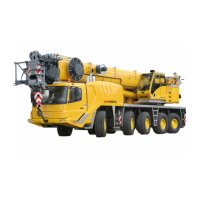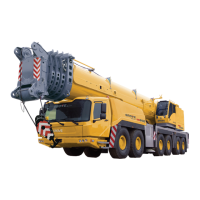OPERATING PROCEDURES GRT9165 OPERATOR MANUAL
4-22 Published 7-23-2020, Control # 668-02
Setting the Outriggers Using the Auto-Level
Feature
Start with outrigger beams and jacks retracted.
NOTE: ECO mode does not work when operating the
outriggers.
1. Enable the outrigger functions by doing the following:
- Shift transmission to neutral
- Engage the parking brake.
- Engage four-wheel drive
- Disable all crane functions
- Fully lower cab
2. Position the outrigger pads directly out from each
outrigger to where the outriggers will be properly
extended.
3. If required, extend the outrigger beams to the
mid-extend or fully extended position using the
Outrigger Extend/Retract Switch and the Operator
Display Module (refer Outrigger Extend/Retract, page
4-100).
Refer to Engaging the Outrigger Mid-Extend Lock Pin,
page 4-23 if the crane is to be operated with the
outriggers at the mid-extend position.
NOTE: More than one outrigger beam can be extended at
a time. To make sure each outrigger is fully
extended, repeat step 3 for each outrigger after a
multi-outrigger extension.
4. Extend the outrigger jacks using the Outrigger
Extend/Retract Switch and the Operator Display Module
(refer to Extending/Retracting Individual Outrigger
Jacks, page 4-103 or Extending/Retracting the
Outrigger Jacks - x4, page 4-104).
Extend each outrigger jack until the locking levers of the
pad engage the jack cylinder barrel.
5. Fully extend the four outrigger jacks.
6. Begin the automatic level process using the Outrigger
Extend/Retract Switch and the Operator Display Module
(refer to Leveling the Crane Using Auto-level, page
4-105).
The crane will react in the following manner:
a. Briefly extend all four jacks
b. Briefly retract all four jacks
c. Begin adjusting by lowering two jacks at once until
level position is reached.
d. There may be several long pauses after lowering for
the inclination sensor to stabilize – keep holding the
buttons through these.
7. Leveling is complete when out-of-level by less than 0.1
degrees and the Auto-level Indicator (1, Figure 4-104)
flashes.
Outrigger Monitoring System (OMS)
The Outrigger Monitoring System (OMS) aids the operator in
accurately programming the Rated Capacity Limiter (RCL)
by automatically identifying the horizontal position of each
outrigger beam. The OMS uses four sensors, one per
outrigger beam, to indicate when an outrigger beam is
positioned to one of three pre-defined locations, including
fully retracted, mid-extend, and fully extended.
Outrigger setup is the same for cranes equipped with OMS;
refer to Setting the Outriggers Manually, page 4-21.
If crane is setup on outriggers and “On Outriggers” is
selected when programming the RCL, then the OMS
indicates to the RCL the horizontal position of each of the
four outrigger beams. If the outrigger beam configuration
programmed by the operator does not match that which is
detected by the Outrigger Monitoring System, an outrigger
beam over-ride warning screen will appear [refer to
Outrigger Span, page 4-162]. The RCL does not lock-out the
crane or select a different load chart based on the outrigger
beam position that is identified by the OMS.
DANGER
Tipping Hazard!
The mid-extend outrigger beam lock pin must be engaged
before operating on any beam from the mid-extend
position.
Operator must select the proper rigging code from the
load chart and RCL program for the outrigger position
selected. The Outrigger Monitoring System (OMS) will
NOT change the rigging code to match the existing
outrigger position.
DANGER
Tipping Hazard!
All four outrigger beams must be equally deployed to one
of three positions before beginning operation, which
include fully retracted, mid-extend, or fully extended. Do
not operate the crane with the outriggers in any other
position.

